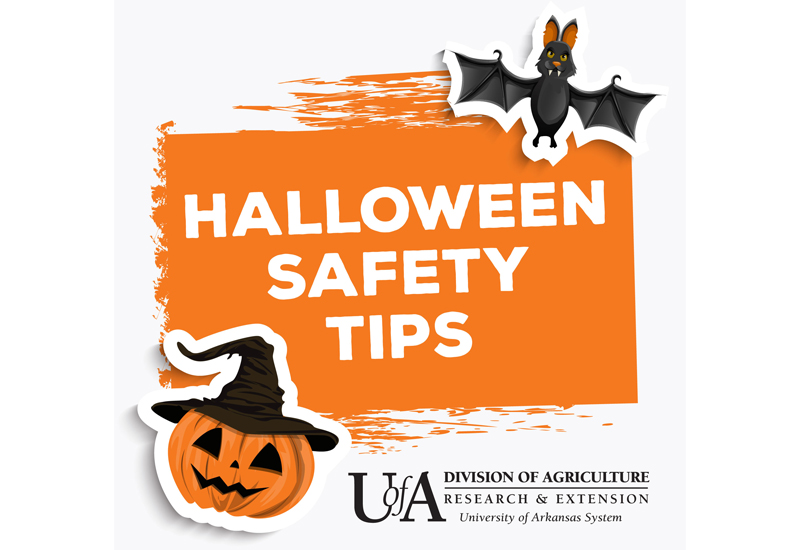Tips for safe trick-or-treating and candy consumption this Halloween

To ensure all children enjoy spooky fun this Halloween, it’s important for parents to establish safe trick-or-treating plans and include children with food allergies in the holiday’s festivities.
Quad Whitson, extension culinary nutrition program associate for the University of Arkansas System Division of Agriculture, said it’s critical for parents to always accompany young children during trick-or-treating.
“If trick-or-treating at night, stay close and always keep a watchful eye on them,” Whitson said. “Some Halloween activities are offered earlier throughout the day at churches, local businesses, community centers, schools or “trunk-or-treat” events in parking lots. Attending these types of events can be safer, and this also allows your child to stick to their regular bedtime.”
For older children who have been given permission to trick-or-treat with their friends, Whitson said parents should establish and review an acceptable and safe route for them to follow.
“Emphasize staying together as a group and help brainstorm ideas to ensure everyone makes it home safely by a predetermined time,” he said.
Parents should also discuss the importance of minimizing distractions while walking, especially for children with access to electronic devices.
“Staying on well-lit streets and utilizing sidewalks and established crosswalks can reduce the risk of unfortunate vehicular accidents,” Whitson said. “Motorists often have trouble seeing children, especially if their costume colors don’t stand out and blend in with the surrounding environment. Consider adding reflective tape or striping to costumes for better visibility.”
Whitson said parents should also keep the following practices in mind:
- Remind children never to enter a stranger’s house or receive a ride home from a person or people they do not know.
- Before letting children eat any candy, sort and check them to ensure they have not been tampered with. Closely examine all treats and throw away anything unwrapped, spoiled or suspicious. If in doubt, throw it out!
- Depending on a child’s age, some treats can be a choking hazard. Babies and toddlers should not have any hard candy, popcorn, gum, small candy, or anything with nuts or seeds.
Establishing healthy relationships with sweets
Whitson said that though parents may be tempted to enforce strict, rigid rules around candy consumption for their children, this can be an opportunity for children to “learn mindfulness and stay calm around sweet treats.”
“As parents, you have the best interest in mind for your child, which may result in concerns that your child may ‘eat too much candy’ or become ‘addicted’ to sugar on this holiday when sweets are so abundant,” Whitson said. “These fears that parents have for their children can usually be attributed to their own experiences as kids. Maybe you were told that if you eat too much ‘junk food’ or candy, you’d ‘ruin your teeth’ or perhaps even ‘gain weight.’
“It’s integral that positive relationships are created around all food, including sweets,” Whitson said. “The best way to do this is to not micromanage your child during this joyous time, and instead allow them to learn from their experiences — most kids learn that having way too much candy is not necessarily a good thing and will learn to regulate their intake of treats down the road.”
Whitson suggested that instead of getting angry and punishing children for overeating candy, approach the situation with kindness and care, and discuss the problem together.
“Ask why they think they feel sick, what they could do next time to avoid the same feeling, and ultimately explain that overeating candy takes the fun out of Halloween.”
In the first two years of life, children do not need candy and other treats high in sugar, such as soda and sports drinks. For children aged two to four who have not had much opportunity to develop self-regulation skills, they will need help managing their candy stash.
“Try helping them out by giving them a daily amount of candy spread throughout the day that seems fair — maybe two or three pieces — and allowing them to decide when they will have it, such as one with their snack, lunch and dinner,” Whitson said. “Children older than four years old are likely ready to begin managing their candy stash with boundaries, such as when and where parents designate eating to occur.”
Whitson said taking this approach can help deal with some of the adverse effects of high sugar consumption, such as cavities and digestive issues.
Even with food allergies, make time for fun
Whitson said it is essential that children with food allergies are not left out during Halloween fun with friends and family.
“Accommodate your child,” Whitson said. “Halloween can be scary for parents of children with food allergies but allowing them to participate in events such as trick-or-treating with their friends can still happen.
“To better accommodate them, establish ‘safe homes’ on your predetermined route by talking to friends or neighbors to see if they could have allergy-friendly or non-food treats available for your child when they come by, so they can still participate and get that classic Halloween experience,” Whitson said.
Parents could also try the following ideas:
- Consider a “trading system” with your child. This system consists of your child trading out a candy or treat they receive for safe candy or snacks, or perhaps toys, that they would typically enjoy.
- Make Halloween about more than just candy. Brainstorm with your child about other aspects of the holiday, such as creating their costume, carving pumpkins, or planning a Halloween party with games and carefully chosen food items.
Parents should always carry epinephrine and other life-saving medications. Be sure to always have a child’s epinephrine device on hand in case of an emergency.
“Accidents happen sometimes, but being prepared can help ease tension surrounding this time, making the experience more enjoyable for everyone,” Whitson said.


